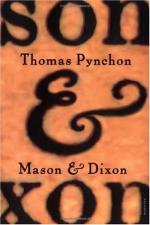|
This section contains 602 words (approx. 3 pages at 300 words per page) |

|
Pynchon's postmodern style of writing allows him use of literary precedents ranging from Boccaccio's fourteenth century Decameron (1353), a collection of tales told by people on a journey, to Umberto Eco's The Island of the Day Before (1995; see separate entry), a novel about Italians who join the international race to calculate accurate longitude.
The novel's archaic spellings and capitalization are reminiscent of Henry Fielding's Tom Jones (1749) and Oliver Goldsmith's The Vicar of Wakefield (1766). Both writers satirize eccentric characters and social problems of the eighteenth century.
Closely related in its postmodern style and content to Mason & Dixon is John Barth's novel, The Sot-Weed Factor (1960; see separate entry). It is a humorous parody of the style and diction of Fielding's TomJones and Captain John Smith's The General History of Virginia (1608).
James Michener has written two lengthy novels about settings similar to those in Mason & Dixon. The Covenant (1980) covers the...
|
This section contains 602 words (approx. 3 pages at 300 words per page) |

|




